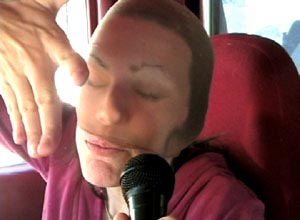Arts & Culture
The Art of Work
By Kerensa Edinger Milwaukee already has an art museum that in itself is a feat of engineering, but a museum dedicated to the art of engineering is another thing altogether. It may seem an anomaly, but we now have one of those, too. The new Grohmann Museum, on the campus of the Milwaukee School of Engineering (MSOE), is home to Man at Work: The Eckhart G. Grohmann Collection, the largest and most comprehensive of its kind. From agriculture to alchemy, coal mining to tax collecting, the approximately 700 paintings and sculptures display the vast breadth and evolution of human industry. With few exceptions, the artwork comes from the private collection of Dr. Eckhart Grohmann, an MSOE Regent, Milwaukee businessman and avid collector. Grohmann grew up in Germany, where he would often visit his grandfather’s marble processing business and quarry in Silesia (now part of Poland). In watching the stonecutters and sculptors toil to select and transform their raw materials, he developed an admiration for the beauty of work. To Dr. Grohmann, work is an essential, evolving aspect of human progress. Currently the chairman and president of Milwaukee’s Aluminum Casting and Engineering Company, which makes high-volume aluminum components for the automotive industry, Dr. Grohmann began his extensive art collection in the 1960s. Grohmann and his wife, Ischi, have long contributed to scholarships for MSOE students and donated funds to buy the property for the Kern Center, MSOE’s health and wellness facility, just a block from the museum. In the same philanthropic vein, Grohmann donated his collection for the purpose of establishing a museum and provided the funds to purchase and renovate the building that would house it. Constructed in 1924, the three-story, 38,000 square-foot concrete structure was home first to an automobile dealership, Metropolitan Cadillac, and then later occupied by the Federal Reserve Bank until 2004. To fit the needs of the Federal Reserve Bank, the building had relatively small windows and secure, anonymous entrances. MSOE purchased the structure in 2005; demolition and renovation began in September of 2006. Uihlein-Wilson, the project’s architects, kept the small windows –ideal for allowing in just enough light to preserve the delicate artwork – but replaced the corner of the building at Broadway and State with a glass cylindrical atrium capped by an open metalwork dome. Soaring over the museum’s entryway is the 700-square-foot mural, its two hemispheres, Vulcan’s Forge and Great Minds of History, linked by a spinning celestial wheel. Vulcan’s Forge reinterprets The Element of Fire, a 16th-century painting by a student of Francesco Bassano that depicts the Roman god Vulcan forging arrows for his son Cupid while Venus, combing her hair with one breast demurely bared, looks on. For his mural, the German artist H.D. Tylle lifted these primary figures from their cluttered, gloomy backdrop and set them against a simple landscape of rolling hills and blue sky. He used live models and new costumes to paint the figures, transforming the placid, stylized originals into striking creatures of flesh and blood. The […]
Nov 1st, 2007 by Vital ArchivesRecalling the Wisconsin Idea
By Barry Wightman A century ago there was a political agenda known as the “Wisconsin Idea.” As Sanford D. Horwitt, author of Feingold: A New Democratic Party, puts it, the idea at the center of then-nascent progressive political thinking “became widely known as shorthand for new, enlightened rational government that would rein in laissez-faire capitalism, invest in vastly expanded educational opportunities and infrastructure, and use the expertise at the University of Wisconsin to create pioneering programs to promote the health, safety and economic interests of ordinary workers and farmers alike.” One would be hard-pressed to argue with that agenda. Famed Wisconsin Governor and Senator, Robert M. La Follette, one of Russ Feingold’s political heroes, personified the progressive Wisconsin Idea. And understanding La Follette is key to understanding our current senator. Having read La Follette’s autobiography as a high school student, Feingold was steeped in the progressive tradition. Simply put, true progressives believe in competence, community and thrift and are fervently against the power of big money and behind-the-scenes influence. With roots in the Northern European traditions of many of Wisconsin’s 19th century settlers, progressives cover a wide political spectrum that, in today’s terms, is neither red-state nor blue-state. And it is that pragmatic, party boundary-crossing approach that is central to Feingold’s politics. Progressivism as a coherent political movement is largely forgotten, its tenet planks scattered among the dusty platform statements of the two major parties of the 20th century. But Feingold is, by the historic definition, a progressive. Asked about the prospect for a progressive revival in 21st century America, Feingold was hopeful. Saying that his hero Bob La Follette would be “passionate” about today’s possibilities, Feingold is clearly working to speak for the independent, pragmatic and public-minded of Wisconsin. Those are not the words of cautious man. Feingold’s habit of confounding the leaders of the Democratic Party establishment would have been familiar to “Fighting Bob” La Follette. Feingold’s was the lone vote against the Patriot Act in 2001 and he was one of the few to vote against the authorization for war against Iraq in 2002. He was also the only Democrat to vote to continue the Senate Clinton impeachment proceedings in 1998 – a very unpopular position, at least among Democrats. And with Republican maverick John McCain, he has consistently championed campaign finance reform, attempting to drive corrupting big money from the national political process. Feingold, Horwitt writes, can be counted on to vote for reform, not to play it safe. As a result, Feingold frequently tangles with his more cautious contemporaries. His 2002 public dust-up with Senator Hillary Clinton on campaign finance – she claimed he wasn’t living in the “real world” – rocked the party boat, as did the recent failed Feingold-Reid Senate bill to end the Iraq war. Many Democrats veered away from him. But Feingold remains undeterred, going about the business of serving his state and nation unbowed by what some might perceive to be political failures. In speaking about the war at one […]
Nov 1st, 2007 by Vital ArchivesBruce Springsteen
Bruce Springsteen’s career has been truly beyond reproach. Even those who aren’t fans have to acquiesce to the fact that he’s the definition of integrity in a business that thrives on the opposite. And while his popularity may have waned in the nineties, he still created provocative music that meant something both to him and to his audience. This is evidenced by recent releases from a number of young artists mining his sound and his aesthetic. Ah, but they could never be the real thing. And here in his 24th year of recording, Bruce produces yet another finely-crafted testament to his “Boss” title. Magic contains the most direct and immediate collection of rock music Bruce has put out since Born in the U.S.A. in 1984. The saxophone, the piano and the rest of the E Street Band are back in full regalia on songs like “Livin’ In The Future” and “I’ll Work For Your Love.” The driving rhythms, melodies and narratives are also back, particularly on “Last to Die.” But Bruce doesn’t stop there: on the title track he displays the entire spectrum of his talents as a creator. “Girls In Their Summer Clothes” is as innocent as it is wistful. And though it may turn some people off, there are also a number of songs that touch upon his acoustic, rootsy leanings, sparse and epic. Bruce makes albums that are the equivalent of audio novels. They tell stories, weave descriptions, paint landscapes and define characters. But he also always gives us a little prize wrapped in the theme of it all: the emotional resource that compels us to be the authors of our own existence. “Love (and attitude) is a power greater (and stronger) than death” he sings in his tribute to a deceased friend on the hidden track 12, “Terry’s Song.” Yep, that’s the magic.
Nov 1st, 2007 by Troy ButeroHow do you measure ten years?
It was almost an overnight success — an iconic piece of Broadway that infected the hearts and minds of thousands. Personally, I don’t see the appeal. I tend to agree with Cintra Wilson who once described it as “Cats with AIDS.” Think of it what you will, there is no denying the fact that Rent is now over a decade old. The fact that people are still performing it means that people are still seeing it. It came to the Milwaukee Theatre this past weekend on its way to Illinois, Louisiana and a host of other engagements. In spite of little advance publicity and almost no advertising, opening night was well attended. I was there. I was in college when Rent debuted Off-Broadway, and I am only a few years younger than Rent’s writer/composer Jonathan Larson. The costuming, set design, and overall visual aesthetics of the original musical, which are maintained in the touring production, came from the mid-nineties. It’s a look which will live on for decades to come in subsequent productions long after contemporary fashion has rendered them silly and antiquated. With its continued success and barely wavering popularity, Rent is my generation’s Hair. Seeing an audience filled with high schoolers feels strange. These kids were in grade school when Rent debuted. They’re watching Rent the same way my generation watched mid-80s John Hughes movies like The Breakfast Club and Sixteen Candles. They’re seeing a freshly-minted retro-pop-culture beginning its slow, steady march into nostalgia, then old age. They don’t know people like the characters in Rent. They will have to wait at least another ten years to see bizarrely romanticized musical theatre versions of people they knew ten years ago singing and dancing onstage. Rent still has that distinctive feel of genuinely good core music that’s been shellacked to a disturbingly glossy sheen. If you happen to be into that sort of thing, the show still holds up remarkably well. Jed Resnick and Heinz Winckler open the show as Mark Cohen and Roger Davis — a filmmaker and a musician living in a questionable apartment in New York. Anwar F. Robinson (evidently of American Idol fame) stars as their friend Tom Collins. The plot, a series of isolated events hazily woven into a central story, is about as coherent as it was a decade ago. There are singular moments that feel reasonably timeless – there’s still quite a bit of power in “Seasons of Love,” for instance –but some of it feels dated. It’s surreal to hear the audience “moo” at the appropriate moment in “Over the Moon,” as though they were all programmed to do so, and when the characters sing of dreams of opening a restaurant in “Santa Fe,” the production enters a time warp. A number of people from my generation went to New Mexico to pursue their dreams and ended up lost somewhere between the mesa and Burning Man, never to return. For the right people, this is a pleasant trip to big Broadway […]
Oct 30th, 2007 by Russ BickerstaffSeven Guitars
By Jill Gilmer Who would believe that backyard banter could capture the soul of an entire people struggling to realize their dreams in the wake of economic and political oppression? This was the ambitious goal of August Wilson’s elegantly-written Seven Guitars, which opened University of Wisconsin-Milwaukee’s fall season Tuesday night. Seven Guitars is part of the Pulitzer Prize-winning playwright’s 10-play series, “The Pittsburgh Cycle.” The series explores the African American experience by peeking into the hearts and minds of working class blacks in Pittsburgh during each decade of the 20th century. Seven Guitars takes place in 1948 in the backyard of town gossip Louise following the funeral of Floyd Barton, a charismatic guitarist and ladies’ man. Floyd’s freshly-successful musical career was cut short when he was imprisoned for a minor offense and later mysteriously murdered. Through a 3-hour flashback, Louise and her neighbors recount Floyd’s life through his relationship with the other six cast members. The most significant of these characters are Hedley, a West Indian chicken sandwich vendor who appears to be teetering on insanity; Vera, Floyd’s plain-Jane girlfriend whom he abandoned to run off with a woman he claims believed in his dreams more deeply; and Canewell, Floyd’s fellow band-member and friend. The play is as much poetry as prose. Its somber social messages seep into our hearts gently and unexpectedly through humor and music. But while poetry and lightness give this play a more hopeful, upbeat quality than some of Wilson’s plays, it is not enough to offset an almost unbearably tedious first act. The UWM student cast does a commendable job with this difficult material, but it lacks the maturity needed to capture the passion in these complex characters – essential to keeping the audience focused during the passages of rambling dialogue. The Generation Y ensemble may have had difficulty connecting with the language and lifestyle of the 1940s. A notable exception was David R. Weaver, Sr., who plays Hedley, an older character. Hedley’s nearly constant state of rage offers a bridge between the frustrations that blacks faced in the 1940s and the anger beneath the violent crime plaguing many inner city neighborhoods today. The younger male characters were most convincing when they described their encounters with the justice system. When one of them stated, “I was arrested for being worthless,” he seemed to be giving voice to the agony of the current generation of African American males, which is experiencing grossly disproportionate rates of incarceration. Other notable performances were Leandra Renaa Williams as Ruby, Louise’s frisky mantrap niece, and Stephanie Roland as a nicely underplayed Louise. Louise’s deadpan lines might tempt many an actress to become a scene robber. The play’s shortcomings are partially corrected by a warm and inviting set, lovingly crafted by Bruce Brockman, and dramatic lighting by Stephen Roby White. Director Bill Watson may have missed an opportunity to soften the dialogue through greater use of music, as some other productions of Seven Guitars have done. Music would have tapped into the […]
Oct 30th, 2007 by Vital ArchivesA Vision Defined
Nov. 3 – Dec. 1 Opening Reception: Nov. 3, 6-9pm A year ago, Whole Foods Market opened to much hoopla and artist Matthew Kirk’s work was selected to add some “local flavor” to the sprawling food emporium. The installation of his work, arranged by Hotcakes Gallery proprietor Mike Brenner, went off without a hitch. It was removed shortly thereafter. Whole Foods explained “it didn’t fit Whole Foods’ Corporate image.” However, it is a good match for Hotcakes, a gallery at 3379 N. Pierce St. in Riverwest, known for innovative and quality exhibits. Kirk’s solo event, his second at this venue, opens with a reception on Saturday, November 3, and runs through December l. In his artist statement for hotcakesgallery.com, he says he “makes pictures to convey the sense of loss and aimlessness that I feel from growing up in a society that has only one vision, and one place, for what an American Indian is, or should be.” His biography notes he was born in Arizona on a Navajo Indian reservation. But need we feel sentimental about that? Painting a Hat, 1914. Edward Curtis. I’ve seen the paintings and prints of Karl Bodmer and George Catlin, and nostalgic photographs by Edward Curtis, and though they depict American Indians, the makers of the art are non-Indians on what smacks of a sentimental journey. However, the images are gorgeous and are important in the history of art making. In the Milwaukee Art Museum’s Bradley Collection, there used to be (and I hope there still is), a painting (Untitled, 1976) by Fritz Scholder, the first artist to paint American Indians surrounded by flags, beer cans and cats – a big leap from the formal portraits produced by Curtis in the early twentieth century. Scholder’s work intrigued me, not because he was an American Indian, or because his painting depicts an American Indian. What intrigued me was his bold palette and broad painterly strokes, so typical of the unfettered art world of the ’70s. Indian in the Snow, 1972. Fritz Scholder. A few years ago, I saw the paintings of Shonto Begay at the Phoenix Art Museum. His website identifies him as a Navajo artist with a Bachelor of Fine Arts from California College of Arts and Crafts, practicing since 1983. I emailed him about the Hotcakes exhibit and asked for permission to use one of his images. He replied thusly: “I have no problem helping a fellow Navajo showing far from home or anywhere … It is an interesting situation being a Native visual artist, and how we view ourselves. Marginalized and anthro material even in our most creative and free expression. Anyway, Curio or not, we love what we do and hope to continue.” “Curio. Marginalized and anthro material.” Kirk and Begay have never met, but it sounds like they share similar thoughts about “loss and aimlessness.” Kirk’s artist statement expands on this by saying it comes from “growing up in a society that has only one vision, and one place, for […]
Oct 29th, 2007 by Judith Ann MoriartyInternet killed the video star
Kimberly Miller could be seen as a backward artist in a digital world where YouTube, Metacafe, and Google are the standard mediums of delivery for video art. But due to the omniscient control of the internet viewer, a piece of experimental art or an installation viewed online is kind of safe. It doesn’t help that some of Miller’s pieces incorporate a live element, requiring her to be present. But what is conveyed is so much stronger in person than when someone is home alone, crouched in front of a monitor. While it’s not easy to describe or interpret her work, the viewer always feels something, however ineffable. More questions are raised than answered. If you were having a conversation with Miller she might say “It’s like, you know?” Then you say, “Yeah. It’s all …you know?” This Friday, October 26, at 7 p.m., Kimberly Miller will present selected works on film at Woodland Pattern, where she is hosted and spotlighted by friend and filmmaker Sarah Buccheri. The presentation of selected works and the reception that follows will give the audience a better chance to ask questions and negotiate with Miller regarding her art – which is exactly what she wishes to encourage with her body of work. VS: Is the presentation Friday reflective of what you’re currently working on, or a collective of past and present work? Kimberly Miller: The screening on Friday will show a selection of my video work from the past few years, including a video I made last week. The work represented will be a section of videos and performances-for-the-camera. There will be a live performative element as well, but a bit of a toned-down one. The emphasis will be on the videos. So on a scale of performance from subtle to Vegas-style flashiness: Sequins and glitter? Maybe. Live doves or flying daggers? Probably no. VS: What is your artistic purpose? KM: In my work I’m trying to … grasp certain things, figure them out. What, if any, role can art play beyond cultural production? Does art have the ability to affect change? Is there such a thing as a radically democratic art experience, and if so, what does it look like? Does action determine the actor, is identity determined by what we do, what we say, some combination thereof? I don’t know the answers to these or any other questions, really, but I’m interested in reframing them again and again and attempting to put out some kind of response to the questions. VS: Why did you choose these mediums to convey them? KM: The forms of video and performance are structured within and around language, and for me this is a place where public and private may intersect. Language is public because it is shared; our conception of language is shaped by its use. Yet each of us must come to an individual understanding of language. Language shapes meaning, and may be a place where viewer and artist meet. I try to establish certain parameters […]
Oct 25th, 2007 by Brian JacobsonTalking Heads
Angela Iannone in Talking Heads Alan Bennett’s Talking Heads, a series of six monologues, was so succesful in its incarnation on BBC television that it is living another life in live theatre. Milwaukee Chamber Theatre brings these monologues to the stage in two alternating programs at the Broadway Theatre’s main stage this month. The show opened with a performance of Series A — the all female show. In the first monologue, set in sparse domesticity suggestive of the mid-1980s, attractive actress Lesley (Wendy Bazar) relates landing a marginal role in a marginal film solely because of her physical attributes. It’s a clever bit of comedy revealing the true depth lying dormant in a woman who seems to be genuinely shallow, and what Bazar lacks in presentation (her accent, presumably meant to be British, wavered somewhere between that, Scottish and Irish, and occasionally Southern) she makes up for with a charming presence that nearly carries the monologue. The second monologue in Series A, “A Lady Of Letters,” features Raeleen McMillion as a lonely old woman named Irene whose civic-mindedness has reached obsessive levels. She’s writing letters to public officials about every conceivable inefficiency and flaw and casting a concerned eye toward house of the young couple that has moved in next door. McMillion carries Bennett’s repetitious monologue with a captivating performance that easily pulls the show through to intermission. Still, it is unfortunate that Bennett stretched this one out longer than it deserved. Certain plot points are repeated in an apparent attempt to pad out the monologue, and while the character is interesting, Bennett does not delve into her personality enough to keep the monologue fresh for its complete cycle onstage. The show returns after intermission with Angela Iannone in “Bed Among the Lentils.” Iannone, who has shown considerable talent for monologue, plays Susan, a vicar’s wife. Strikingly articulate, Susan is recognized solely for her status and otherwise rarely gets any attention. Here she speaks to the audience in clear stream of consciousness, relishing the opportunity to speak about whatever she wants. Iannone seems to enjoy the role a great deal, delivering Bennett’s humor with soulfully precise comic timing. A particularly busy weekend for openings didn’t allow for review of Series B, which includes performances by Laurie Birmingham, Norman Moses and Milwaukee Chamber co-founder Ruth Schudson. VS Milwaukee Chamber Theatre’s production of Talking Heads runs through November 4 at the Broadway Theatre Center’s Cabot Theatre. Tickets can be purchased in advance by calling the box office at 414-298-7800 or online at www.chamber-theatre.com.
Oct 23rd, 2007 by Vital ArchivesSITE unveils Fall 2007 installations
Much of Milwaukee’s art revival is concentrated in the condo-ready Third Ward, so it seems a brave feat that a two-block stretch – beginning at the struggling, yet bustling 3500 block of West North Avenue – is seeing a revival of its own. It’s strange and wonderful to see art and vitality on an arterial street that doesn’t share the business or attention of its East Side and Wauwatosa bookends and this installation, organized by IN:SITE, purveyors of public art, features artists Laura Gorzek, Chris Murphy and Kasia Drake. The untitled exhibit opened on October 27, and each of the three installation promises to provoke and inspire. “The thing about public art that I don’t always like is when it advocates a certain point of view,” says Laura Gorzek, a photography-based artist currently attending UWM. “I’d like to keep it more open-ended … letting [viewers] draw from their own experiences, their own level of dealing with something.” Gorzek’s piece, Surface v. Secret, incorporates elements of her photographic works on four vinyl-constructed banners across a large 8-by-24 foot billboard at 3615 W. North Ave. With her artwork she hopes to address women’s identities and self-perception – what is apparent and what lies hidden. Each piece demands multiple viewings to grasp the complex, layered narrative thread. “I thought it would be interesting to try this – most of what I do is more intimate and private. So juxtaposing this to a public space, it’s like making private life more universal,” says Gorzek. Chris Murphy’s piece, Choros, has been gestating for awhile. Murphy watched day after day since last summer as stories of Milwaukee’s homicides racked up on the news. “Someone else is shot again. I mean, I lived in Oakland, California and it didn’t seem this bad,” says Murphy – a master electrician, artist and father. “I’m a very 3-D person, and I thought about ways to put a face on it.” Choros – Greek for the chorus of masked players in tragic plays who offer background or commentary – is composed of scores of semi-translucent masks molded from the faces of real volunteer subjects. The gauzy masks, made of quick-drying water-based resins, are mounted on a maroon backdrop at 3611 W. North Avenue, each lit from behind by LEDs. They represent each person killed by gunshots in the city this year. At night the sculpture takes on an ethereal quality. “I just want to have [the viewer] acknowledge it as a first step,” says Murphy. “I want to humanize the whole thing instead of victims being a whole number. These people are not going to show up to the dinner table – they’re gone.” The final project, by fabric artist Kasia Drake and 11 collaborators, continues the international You Are Beautiful campaign started by anonymous artists in Chicago. It is installed in the long-standing Milwaukee Paint Store windows at 3532 W. North Avenue. YAB’s mission is to “reach beyond ourselves as individuals to make a difference by creating moments of positive […]
Oct 22nd, 2007 by Brian JacobsonThe Woman in Black
Renaissance Theaterworks revives the classic art of scary storytelling with Stephen Mallatratt’s wildly successful The Woman In Black. Based on the novel by Susan Hill, The Woman In Black tells the story of a man trying to escape ghostly events his past that have haunted him for years. The play, one of the longest-running productions in the history of London theatre, comes to the stage of the Broadway Theatre Center’s Studio Theatre in a remarkably well-balanced Renaissance production. Milwaukee Rep resident actor Jonathan Gillard Daly plays a London solicitor who seeks to deal with traumatic events from his past by performing a staged reading of his recollections. Unskilled in the art of public performance, the solicitor enlists the help of a charismatic young stage actor named Arthur Kipps (Bran J. Gill.) As Kipps consults with the solicitor in an empty theatre, the story takes on a life of its own. As an actress, Mary MacDonald Kerr has proven her ability to bring drama (Burn This) and comedy (String of Pearls) to the stage vividly and with grace. In directing The Woman In Black she has put together a spook story with enough startling moments to keep an audience interested from beginning to end. Kerr makes clever staging decisions in the reasonable intimacy of the studio theatre. With the aid of ubiquitous lighting guy Jonathan Fassl, Kerr draws a moody atmosphere of light, shadow and darkness around a classic ghost story featuring two talented actors and a pair of equally talented shadows. Daly’s real challenge here seems to be the art of pretending he knows nothing about theatre as his character. It’s strange to see a man with Daly’s extensive stage experience pretending to be theatrically challenged. Daly presents his character as a man taking a liking to telling the story in a full theatrical production complete with recorded sound effects. The darkness of his tragic memories is barely on the edge of his consciousness as he delves deeper and deeper into the past. Gill’s stage charisma sells the role of actor quite well. The character becomes more complex as the story starts to develop its own momentum, but Gill manages a reserved sense of fright as he is immersed in the solicitor’s memories. Rebecca Phillips and Emily Trask round out the cast as shadowy figures. The most impressive part of their performances here is what isn’t seen onstage. Thanks to stage tricks, they’re maneuvering around in what must be something very close to total darkness to strike the perfect pose as the lights suddenly flash to reveal them. As often as this happens, it never ceases to be a shock. Renaissance Theaterworks’ production of The Woman In Black runs through November 4 at the Broadway Theatre Center’s Studio Theatre. Tickets can be purchased in advance by calling the box office at 414-291-7800 or online at www.r-t-w.com.
Oct 19th, 2007 by Russ BickerstaffEvery Picture Tells a Story
In becoming a photographer, one makes a choice to be the teller of stories rather than the subject, witness to the deeds of others, a visual historian to a particular moment in time Milwaukee photographer Jim Herrington has stories of his own, of course, but what fascinates is his body of work – and that’s the way he wants it. He has a gift for capturing the essence of his subjects, preferring native settings over studios and just shooting until he captures that perfect moment. “It’s like writing a song. Sometimes it’s there from the beginning and you have to get out of the way and let it happen.” To peruse Herrington’s portfolio is particularly delightful for lovers of American music. There’s almost nobody he hasn’t shot, and he has stories to tell about the rest. He also climbs and has incredible pictures, not so much of mountains, but of mountaineers. Something of a dreamer himself, he gravitates towards others like him, recording their visages for posterity and his own collection. Herrington will show work on Gallery Night at Cedar Gallery, upstairs at 326 N. Water St. But what you won’t get on October 19 is a sense of the stories he’s amassed along the way; how his photos came to be, a sense of the person behind each still image. Some of those stories are told here, in his words; a few others are on his website at jimherrington.com. The rest are his own – as it should be. VS
Oct 12th, 2007 by Vital ArchivesThe Wonder Bread Years
Stand-up comedian/writer/commercial spokesman Pat Hazell is touring the country with The Wonder Bread Years, a series of recollections about growing-up as a baby boomer. Local comedian and theatre icon John McGivern takes Hazell’s role in Milwaukee’s production of the one-man show. The set is a stylized suburban front porch, personalized with a few McGivern touches to ground us in 1960s Milwaukee. From tiny kid’s cereal boxes to Kool-Aid and Toughskin jeans, the monologue about childhood in America covers a lot of common pop cultural ground, and anyone who grew up in the US in the 60s, 70s or 80s can make a connection with Wonder Bread Years. Pat Hazell’s performance of the same material was aired some time ago as a one-hour PBS special. Even though Hazell performed his own material, McGivern’s performance far outshines Hazell’s. Hazell’s delivery is heavily rooted in stand-up comedy, while McGivern, whose experience is richer in the theatrical stage, performs with a much more engaging stage presence. When McGivern is onstage, he’s there for far more than telling jokes. He genuinely loves being there. The delivery may feel a little over-enthusiastic in places, but McGivern’s trademark exuberant earnestness makes the material feel much more organic. This is particularly effective when the comedy settles down in poignant observations about the nature of childhood. Hazell’s delivery is detached — like he’s delivering a sales pitch. When Hazell gets serious and sentimental with his own material, it comes across like a speech at a $300 per ticket motivational seminar. When McGivern delivers the same material, is performance caries the kind of authentic ebullience that makes it work. McGivern may be better with The Wonder Bead Years than its original author was, but in places it is clear that McGivern isn’t entirely comfortable with Hazell’s material. When McGivern is performing his own material, there’s a kind of magic onstage – especially in his interactions with the audience. It’s a distinct theatrical experience when a stage presence as strong and dynamic as McGivern talks about his childhood to a packed audience of people who could’ve been in the area when he was growing up. Everyone’s in a theatre, but there’s that distinct feeling that you’re hanging out with a nice guy from the neighborhood on his porch on the east side. VS Pat Hazelton’s The Wonder Bread Years with John McGivern runs through October 28th at the Marcus Center for the Performing Arts. Tickets can be purchased in advance by calling the Marcus Center at 414-273-7206 or online at www.marcuscenter.org
Oct 12th, 2007 by Russ Bickerstaff
















